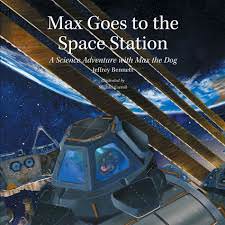Book review by David L. Hamilton
Jeffery Bennett’s Max Goes to the Space Station is the newest addition to the series A Science Adventure with Max the Dog. This series introduces children ages 4 to 12 to the exciting world of scientific thinking through adventurous story telling featuring a lovable and intelligent dog named Max. Max Goes to the Space Station also includes age appropriate suggested activities spanning grades 1 through 8.
This book uses words and illustrations to tell the exciting tale of Max the dog and his journey to the International Space Station, his adventures while on the station and his return home to his family. The main story is written so that younger children can follow along with Max and his adventures while also providing a “Big Kid Box” on each page for the older children. A “Big Kid Box” is a text box on each page that has more in-depth information for older children. At the back of the book are suggested activities for children in the first grade through the eighth grade. Max Goes to the Space Station is one of the many books included in the Stories from Space program. In this program, astronauts read a book from space while on the International Space Station. This year; 2014, astronauts are scheduled to read this book as well as other books from the series.
Universe Today and Big Kid Science are pleased to be able to offer two free copies of Max Goes to the Space Station to our readers. This contest is open to US and Canadian residents only. In order to be entered into the giveaway drawing, just put your email address into the box at the bottom of this post (where it says “Enter the Giveaway”) before Tuesday, March 24th. If this is the first time you’re registering for a giveaway, you’ll receive a confirmation email immediately where you’ll need to click a link to be entered into the drawing. For those who have registered previously, you’ll receive an email later where you can enter this drawing.
Max Goes to the Space Station and other books in this series are available on Amazon.com.
Max Goes to the Space Station A Science Adventure with Max the Dog [Hardcover] by Jeffery Bennett Illustrated. 32 Pages. Big Kid Science
About the author and illustrator:
Jeffrey Bennett is an astrophysicist and educator who proposed the idea for and helped develop the Voyage Scale Model Solar System—the first science-oriented exhibit approved for permanent installation on the National Mall in Washington, DC. In addition to writing the Science Adventures with Max the Dog series, he is the lead author of best selling college textbooks in astronomy, mathematics, statistics and astrobiology, as well as of critically acclaimed books for the general public. He lives with his family in Boulder, Colorado. Michael Carroll is a renowned space artist, a fellow of the International Association of Astronomical Artists, and a recipient of the Lucien Rudaux award for lifetime achievement in the astronomical arts. His work has been featured at NASA’s Jet Propulsion Laboratory and the National Air and Space Museum; in National Geographic, Smithsonian and Time; and on NOVA. He is also the illustrator of Max Goes to Jupiter. He lives in Littleton, Colorado.
About the reviewer:
David and his wife live in Conway, Arkansas. They are amateur astronomers that love spending nights stargazing and their days working in Higher Education. David graduated from the University of Arkansas at Little Rock with a Master of Education degree.


The ‘Enter the Giveaway link seems to be gone – but for the record my 7y.o. daughter would LOVE a copy of this book. We have glowing stars on the ceiling, nightly chats about the planets and whenever possible we look through my telescope in my shed/observatory. What a great idea for a book!
good to know baileys 2611 as when my daughter is a bit older (only 21 months now), i’ll start discussing these wonderful topics..
So sad to know the Giveaway link be gone. I would like to get a copy of the book for my children students in elementary school, here in La Paz, Baja California Sur, México.
Where can I buy one?
Please answer me.